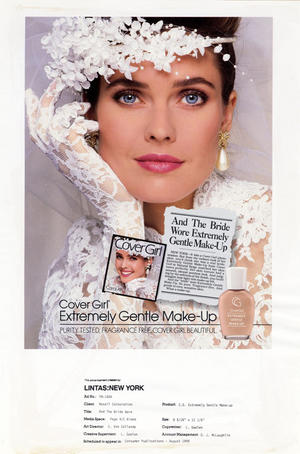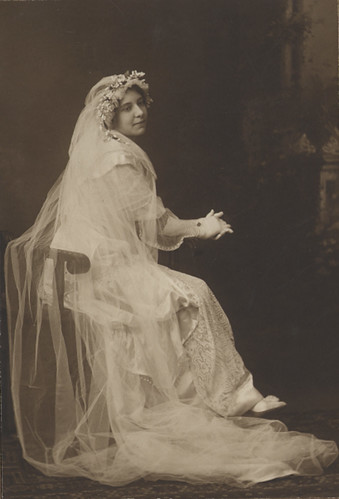Wedding season is upon us, and so it is no wonder that this beauty, with her frothy veil and layers of lace has been very popular on the Smithsonian Flickr Commons. Looking at this photo, I realized I didn’t know why brides wear white wedding dresses and so I decided to do some digging.
Many brides assume that the tradition of the white wedding dress comes from the color’s ancient symbolic association with virginity and purity, but in reality, the white wedding dress is a much more recent development. Surely brides wore white gowns before, but it was Queen Victoria who truly popularized this tradition. While royalty typically wore embroidered brocade and crimson robes for weddings, Victoria donned a white satin gown with layers of lace made by two hundred women and a white veil. The lavish dress and the wedding between Victoria and her cousin Albert in 1840 were written up and illustrated in thousands of publications worldwide. Soon, American etiquette books decreed that the white wedding was the "proper style." The white wedding dress became a symbol of wealth and social status—after all, white could not easily be cleaned or worn again outside of hot summer months, and very few women could afford to buy and wear a dress solely for one occasion. And most likely, our bride above made sure to get to the photographer’s studio for that very reason—to demonstrate that she had the social standing and wealth to have a white wedding dress (and of course, to memorialize an important occasion, her youth, and beauty, as we all like to do!).
 Even so, until recently bridal attire was simply dictated by what a woman had in her closet and by what was au courant. So, while brides in the Western world have worn white, they’ve also donned every other color of the rainbow (yes, even black!). For example, during the Civil War brides often wore purple to respect and honor the dead. By the late 1800s, American and European brides went wild for dresses in the bright, rich colors created by new synthetic dyes. During WWI, many women considered it their duty to give up a "white wedding" in wartime, and during the Depression most brides had no choice, simply making do with their best dress or suit. But in the 1930s, garment manufacturers began specializing in making wedding dresses, and an onslaught of bridal magazines filled with photographs began marketing the white wedding dress as part of a romantic ideal, a custom from "the earliest ages." And whether contemporary brides embrace or vehemently reject the "traditional" white wedding dress, it is this marketing, rather than any ageless tradition, that has made the white wedding dress a ubiquitous part of our visual culture.
Even so, until recently bridal attire was simply dictated by what a woman had in her closet and by what was au courant. So, while brides in the Western world have worn white, they’ve also donned every other color of the rainbow (yes, even black!). For example, during the Civil War brides often wore purple to respect and honor the dead. By the late 1800s, American and European brides went wild for dresses in the bright, rich colors created by new synthetic dyes. During WWI, many women considered it their duty to give up a "white wedding" in wartime, and during the Depression most brides had no choice, simply making do with their best dress or suit. But in the 1930s, garment manufacturers began specializing in making wedding dresses, and an onslaught of bridal magazines filled with photographs began marketing the white wedding dress as part of a romantic ideal, a custom from "the earliest ages." And whether contemporary brides embrace or vehemently reject the "traditional" white wedding dress, it is this marketing, rather than any ageless tradition, that has made the white wedding dress a ubiquitous part of our visual culture.
Produced by the Smithsonian Institution Archives. For copyright questions, please see the Terms of Use.


Leave a Comment